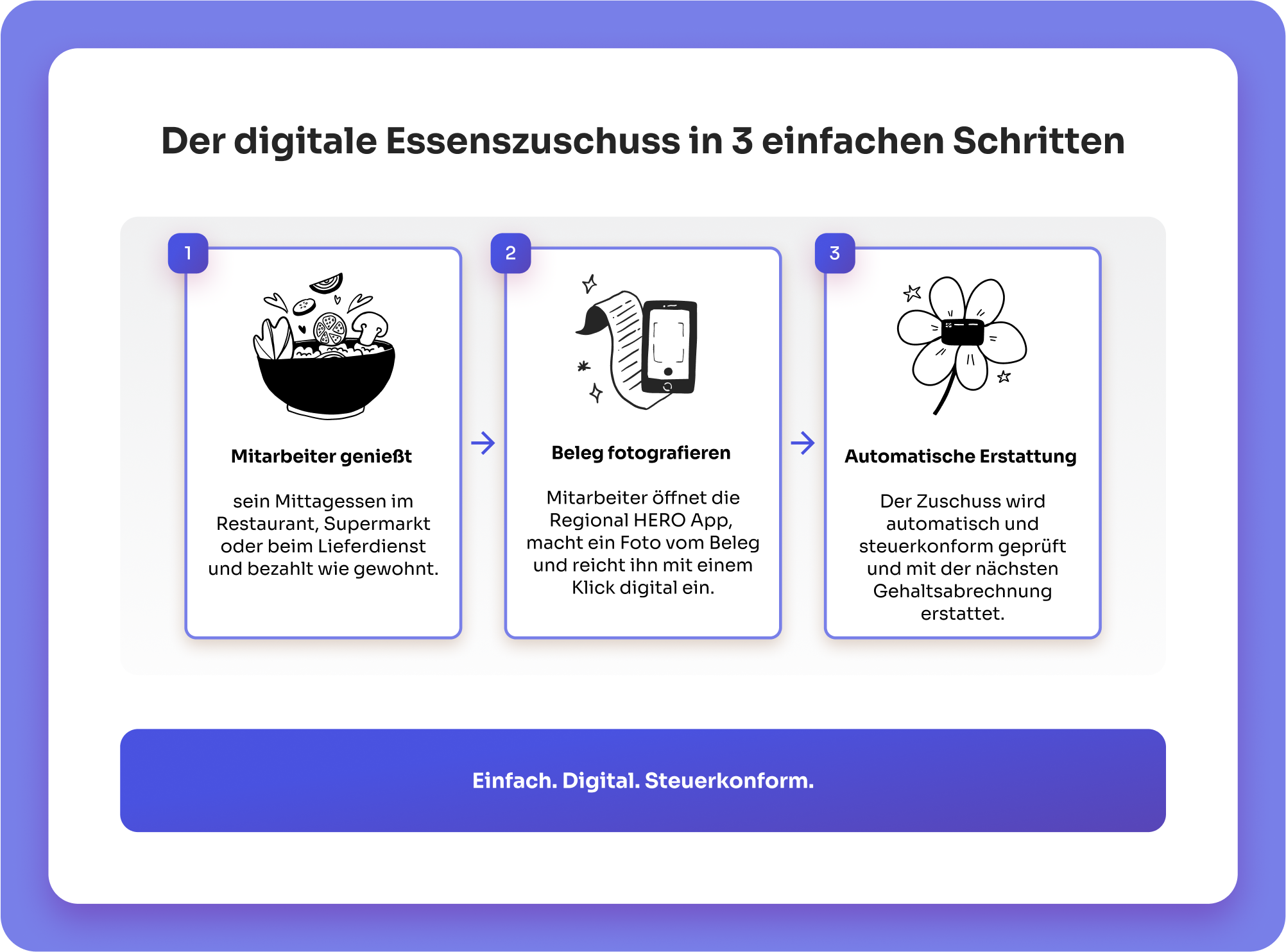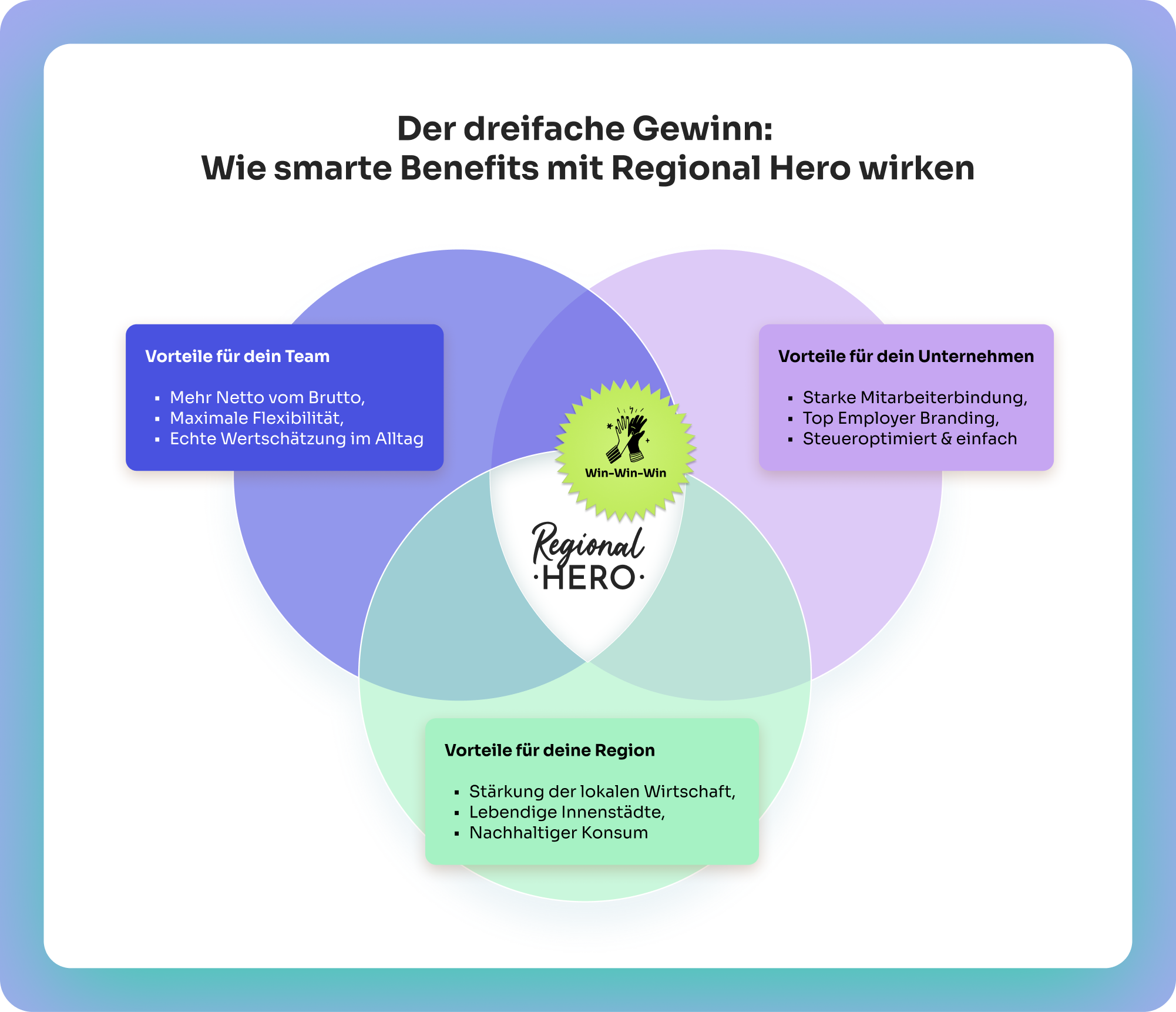

Worker catering: legal basis & tax aspects
Implement professional employee catering correctly ✓ Tax benefits ✓ Statutory requirements ✓ Accounting ✓ Find out more here!

More than just lunch — How to become a top employer with smart catering
Welcome to the new world of work! The competition for the best talent — the “War for Talents” — is in full swing. Classic salary increases may be nice, but a large part of them is often eaten up directly by taxes and social security contributions before they even reach your employees' accounts. So what is the decisive lever to really motivate your team, retain them in the long term and position yourself as a top modern employer? The answer lies in intelligent, tax-free employee benefits. And right here comes the Worker catering into the game.
But the topic is often like a jungle of paragraphs, exemptions, allowances and strict documentation requirements. Many companies are leaving valuable potential unused because they are uncertain which rules apply or fear administrative costs. In doing so, you are giving away a huge opportunity to show genuine appreciation — 100% of which is received by employees.
This guide is your compass through this jungle. We shed light on the darkness, unravel tax law and show you step by step how to use the various forms of employee catering for your company in a legally secure and strategically wise manner. You'll learn how to reward your team with a meal together, make company parties tax-free and provide daily subsidies without sinking into bureaucratic chaos. And we'll show you how modern, digital solutions not only radically simplify this entire process, but also make it a real benefit for everyone: for your team, for your company and even for your entire region.
What is employee catering?
Employee catering includes all meals and drinks provided by the employer for employees. Depending on the occasion and value, these benefits may be tax-free, for example at company parties up to an allowance of 110€ per person or for working lunches as part of exceptional assignments up to an exemption of 60€.
1. The basics: What exactly is employee catering and what isn't?
Before we dive into the details of tax-free borders, we need to clarify the fundamental terms. Because this, in the correct classification, is the key to success — and the biggest source of error. The tax office is looking very closely at these issues, and incorrect classification can be expensive.
1.1. The definition: From coffee and cookies to a 3-course dinner
In tax law terms, there is a Catering Always when the presentation of food and drinks is clearly in the foreground. It is therefore about a wholesome meal that requires a work break or for which you meet specifically. This could be lunch together in the restaurant, the buffet ordered in the office or dinner after a successful project completion.
1.2. The decisive distinction: hospitality vs. attention
This is exactly where the first big trap lurks. Not everything you offer your team something to eat and drink is automatically a meal. The distinction between the so-called attentiveness is decisive for tax treatment and deduction of operating expenses.
Attentions: These are minor gestures of politeness that are common in social intercourse and do not significantly enrich the employee. Classic examples include coffee, tea, water, juices or pastries that you make available during a meeting or simply in the office. Such gifts are none Catering and the costs for it are always too 100% deductible as operating expenses. The decisive factor here is not so much the price, but the volume: Half a roll covered with caviar can still be passed as attention, while a curry sausage with fries is already considered a wholesome meal and therefore as a catering. Be careful with alcohol: Just a glass of sparkling wine to toast can be classified as hospitality by the tax office.
Catering: As soon as it is a proper meal that exceeds the character of a simple gesture, we speak of catering. And there are completely different rules for this — both for employee tax and for deduction as a business expense for you.
The correct distinction is critical. If you mistakenly record catering as an attention, you risk losing the entire business expense deduction. Why Because you have not met the strict recording requirements for catering (more on that later). The tax office then cuts not only 30%, but the full 100% of the costs. For many companies, this uncertainty results in high administrative costs and concerns about making mistakes. This is exactly where modern, standardized solutions come in, which make this complicated individual case review superfluous — such as a digital meal allowance that follows clear and simple rules.
1.3. Operational vs. business: The small difference with a big impact
When it is clear that this is a catering, the next important question follows: Who was present? The answer determines whether you can deduct 100% or just 70% of the costs as operating expenses.
Operationally initiated catering (100% deductible):
Catering is purely operational if exclusively your own employees (and, if applicable, their relatives at a company party). You can claim the costs for this in full as operating expenses. Typical examples include a Christmas party, a summer party, a departmental event or internal training with food.
Business-related catering (70% deductible):
As soon as a single non-company person If a customer, a supplier, a consultant or a potential applicant is present, the entire catering is considered to be business-initiated. In this case, you may only 70% of reasonable catering costs Deduct as operating expenses. The remaining 30% is not tax deductible. Important: However, you can still claim 100% of the input tax from the entire invoice amount.
Practical tip: For mixed events, such as an anniversary party, to which you invite both employees and business partners, the costs can be shared. The portion attributable to your employees is 100% deductible, the portion for external guests is only 70%. However, this requires proper documentation from the participants.
2. The golden rules: tax-free limits & allowances in detail
Now we come to the heart of this guide: the specific figures you need to know to make employee catering tax-free. These limits are often confused, so it is crucial to understand exactly the differences between reason, value limit and type of limit (exemption limit vs. allowance).
2.1. The 60-euro limit: The tax-free working lunch for exceptional assignments
This rule is intended for special situations in everyday working life in which eating together is not a reward but to optimize the workflow.
Occasion: An “exceptional work effort.” This is not an everyday lunch, but a special situation in which catering is “primarily in the company's own interest.” Examples include a lengthy operational meeting, a workshop that lasts into the evening, or the final spurt on an important project where the team has to stay longer.
rule: The cost of the meal must not exceed 60€ (gross) per employee. If you stay below this limit, the catering for the employee is completely free of income tax and social security.
Key pitfall: This rule must not be misused for regular meals. A weekly team lunch, which becomes routine, loses the character of the “exceptional” and is regarded by the tax office as a taxable wage (monetary advantage).
2.2. The 110 euro allowance: How to celebrate tax-free with your team
Company parties are a central element of corporate culture. There is a generous regulation so that happiness is not clouded by back tax payments.
Occasion: A classic company event. This could be a Christmas party, a summer party, a company anniversary or a company outing.
rule: You may up to two such events per year carry out tax-exempt. The total costs of the event (including food, drinks, room rental, program, gifts, etc.) may be per participating employee 110€ (gross) do not exceed. The special thing here: It is a Allowance. This means: If the celebration costs 130€ per capita, only the excess 20€ must be taxed as wages, not the entire amount. The costs for accompanying persons (e.g. partners) are attributed to the respective employee.
2.3. The 60-euro exemption limit: Personal appreciation that counts
Sometimes it's the small, personal gestures that count the most. Legislators have also created a tax-free option for this.
Occasion: A special personal occasion of an employee. This includes a birthday, wedding, the birth of a child, an anniversary of service or a successful examination. Important: General holidays such as Christmas or Easter are not personal events within the meaning of this regulation.
rule: For this occasion, you can give the employee a Subsidy in kind worth up to 60€ (gross) Give free of tax and social security. It could be a bouquet of flowers, a good book or a voucher. But beware: This is a Exemption limit. If the gift costs just one cent more, i.e. 60.01€, will the total amount Subject to tax and social security contributions. This option can be used by every employee several times a year, provided that there is a valid personal reason.
2.4. The 50-euro exemption limit: The flexible all-rounder for monthly benefits
This is one of the most popular and flexible ways to do something good for employees on a regular basis, and a prime example of modern employee benefit.
Occasion: It is no special occasion required. This benefit can be granted every month.
rule: You can give your employees a monthly Payment in kind worth up to 50€ (formerly 44€) free of tax and social security. The same applies here: It is a Exemption limit. If exceeded, the entire amount of the month is taxable. It is also important that unused amounts cannot be carried over to the following month.
This is exactly where the strength of a well-thought-out, digital solution comes in. With the HERO Card by Regional Hero and the HERO Base Benefit makes using this €50 exemption limit easier and more effective than ever before:
Maximum flexibility for your team:
Instead of a dedicated tank or supermarket voucher, your employees receive a monthly credit on a digital Mastercard. They can use this wherever Mastercard is accepted — at their favorite café around the corner, when shopping for the week, at the cinema or in the local bookstore.
Minimal effort for you:
No more annoying buying and distributing vouchers. With the central HR portal, you can load the balances onto your employees' cards with just a few clicks. Everything digital, everything automated.
Unique regional impact:
That is the decisive added value. Every euro that your team spends via the HERO Card goes directly into the local economy. You not only show appreciation for your team, but also become a real hero for your region, strengthen small businesses and revive your neighborhood.
Tax-free limits at a glance: Your cheat sheet for catering for employees
3. The meal allowance: Focus on the most popular benefit
If there is one benefit that is consistently well received by employees of all industries and age groups, it is the meal subsidy. It is practical, noticeably relieves the monthly budget and shows daily appreciation on the part of the employer.
3.1. Why the meal allowance is so popular
Recent studies show the enormous strategic importance of employee catering. For 63% of young workers (Gen Z), affordable food is an important incentive to come to the office in the first place. A survey by Foodji shows that three quarters of all employees regard a catering offer as a greater advantage than other additional services. It's about more than just money: A good lunch break demonstrably increases productivity by up to 20% and promotes social interaction within the team. In times of a shortage of skilled workers, an attractive meal subsidy is therefore a decisive advantage in the competition for the best minds.
3.2. The magic of benefits in kind: This is how the 2025 subsidy is calculated
The tax relief of the meal subsidy is based on the so-called official benefits in kind. These are adjusted annually to the cost of living. The following values apply for 2025:
- Payment in kind for lunch or dinner: 4.40€
- Payment in kind for breakfast: €2.30
The maximum daily allowance that you can give an employee for a lunch consists of two parts:
- The official benefit in kind (€4.40): As an employer, you must tax this amount at a flat rate of 25%.
- An additional tax-free subsidy (up to 3,10€): You can add this amount on top of that without having to pay taxes or social security contributions.
Together, this results in a maximum total daily subsidy of €7.50 per employee for 2025. With 15 working days a month, that's up to €112.50 net extra for your team — a real salary bonus that arrives 1:1.
How taxation works in practice depends on the employee's own contribution:
Case 1: Employee pays at least 4.40€ himself.
- Meal cost: 12,00€
- Maximum subsidy from you: €7.50
- Employee contribution: 12.00€−7.50€=4.50€
Outcome: Since the personal contribution (4.50€) exceeds the benefit in kind (4.40€), your full subsidy of 7.50€ for the employee is Tax and social security free. You don't have to pay a lump sum tax.
Case 2: Employees pay less than 4.40€ themselves.
- Meal cost: 8,00€
- Maximum subsidy from you: €7.50
- Employee's own contribution: €8.00 — €7.50 = €0.50
Outcome: The own contribution is less than the benefit in kind. As an employer, you must pay a flat rate of 25% on the difference (€4.40 — €0.50 = €3.90). The rest of your grant remains tax-free.
3.3. The rules of the game for tax exemption
In order for the tax office to recognize the meal subsidy, a number of clear rules must be met:
- No cash reward: The subsidy may never be paid out as cash. It must be in the form of digital food stamps, vouchers or a receipt.
- In addition to salary: The benefit must be granted “on top” of the salary owed anyway and must not be a salary conversion.
- Only on real working days: No subsidy may be paid for vacation or sick days.
- Obligation to provide evidence: A receipt must be provided for every subsidized meal.
- Suitable foods: The subsidy is for meals for immediate consumption or for food that can be eaten during the break. Alcohol and tobacco are excluded.
3.4. The digital revolution: Stop the clutter of notes!
Traditionally, the meal allowance was associated with enormous administrative effort: handing out paper stamps, collecting receipts, checking them manually, keeping lists, recording them in payroll. A process that is prone to errors and ties up valuable HR resources.
The future is digital, and here it comes HERO Eats by Regional Hero into the game. This solution transforms the meal allowance from a bureaucratic hurdle into a seamless and motivating benefit:
For your employees:
It is brilliantly easy to use. They eat wherever they want — in a restaurant, in the canteen or buy a salad in the supermarket. They then pull out their smartphone, open the HERO app, take a photo of the receipt and upload it. That's it. The subsidy is calculated and credited automatically. Maximum freedom and zero effort.
For your company:
Save up to 85% on administration time. The intelligent system automatically checks the receipts for plausibility and tax office compliance. In the HR portal, you always have a full overview and can be sure that all tax rules are being met. Billing is 100% audit-proof and digital. You define the budget, the platform does the rest.

4. Documentation is everything: The financial-proof hospitality document
Regardless of how good the intent is — when it comes to catering for employees, the following principle applies: No deduction of operating expenses without correct document.40 The tax office notoriously carefully checks hospitality documents during tax audits. The slightest formal errors may result in the total costs not being recognized.42 Complete and accurate documentation is therefore essential.
Checklist: The mandatory information on every hospitality document
A tax certificate of hospitality consists of two parts: the automatic invoice from the restaurant and your own, handwritten additions.
Part 1: The automatic calculation of the restaurant
Make sure that the calculation includes the following points:
- Full name and address of the restaurant.
- Machine-generated with a sequential invoice number (handwritten receipts are taboo!).
- Date of catering.
- Exact list of all foods and drinks consumed with individual prices. General information such as “food and drinks” or “menu 1" is not sufficient!
- Total invoice amount, broken down by tax rates (e.g. 19% and 7%) and the respective tax amount.
- For invoices over 250€, in addition: Name and address of you or your company as the invoice recipient and the tax number or VAT number of the restaurant.
Part 2: Your handwritten additions (to be made promptly!)
You provide this information directly on the back of the receipt or on a separate, attached form:
- Purpose of catering: Be as precise as possible here! General phrases such as “working lunch”, “project meeting” or “customer care” are not enough for the tax office. Specific information such as “Strategy Planning Q3 with Team Marketing”, “Final Project X Discussion with Company Y” or “Recruitment of New Employees Mr. Mustermann” are better.
- Names of all participants: List full names Aller people present, including your own name as the host.
- Your signature as a host.
Special cases explained briefly:
- Tips: Since tips do not usually appear on the machine bill, they must be proven separately. It is easiest if you have received the tip directly from the service staff on the receipt.
- Digital receipts: Good news! The tax office now also recognizes digital or digitized hospitality invoices as long as all of the above mandatory information is included. This was officially confirmed in a BMF letter dated 30.06.2021.

5. More than just food: The strategic value of employee benefits
When we talk about employee hospitality, it's about much more than just compliance with tax laws. It's about a strategic investment in your most valuable asset: your employees. In a job market where skilled workers have choices, a positive corporate culture and genuine appreciation often tip the balance.
5.1. Benefits as drivers for employee retention and motivation
The figures speak for themselves. According to surveys, around 63% of applicants pay specific attention to the corporate benefits offered when providing information about a potential employer.2 Well-made benefits are a powerful tool for reducing turnover. This not only saves considerable costs for recruiting and training, but also secures valuable know-how in the company. A study by Roland Berger confirms that 79% of the companies surveyed use benefits specifically to promote employee retention and satisfaction. Employees who feel valued are more motivated, more productive, and more loyal.
5.2. What employees really want
The fruit basket and free coffee are nice, but they are no longer a decisive advantage. Today's employees want two things in particular: flexibility And a noticeable financial relief in everyday life. Flexible working hours and home office options are at the top of the wish list. This is immediately followed by benefits that increase net income without taking the detour of a taxable salary increase.
The meal allowance is a perfect example of this. A study by Foodji from 2024 found that 73% of young employees think that good food offerings make the workplace significantly more attractive. Another Sodexo survey showed that 64% of respondents consider the catering offer when changing jobs. These benefits are right on the pulse of the times because they offer direct and daily added value.
5.3. The future of benefits is digital, flexible and... regional!
In order to survive the “war for talent,” companies must modernize their benefit strategy. The future belongs to solutions that meet three criteria:
- Digitally: Modern talent expects modern tools. No one wants to deal with paper vouchers or cumbersome refund processes anymore. An app and a digital card that make everything simple and intuitive are the new standard.
- Flexible: One-size-fits-all solutions are out. Employees want to decide for themselves how and where they use their benefits. A flexible budget that can be used for supermarkets, restaurants, gas stations or mobility shows genuine trust and appreciation for individual needs.
- Regionally: This is the greatest opportunity to position yourself as an employer in a unique way. While most benefits are “just” a transaction between company and employee, a regionally oriented system such as Regional Hero a triple win.

By choosing such a solution, you are not only doing good for your team and your company, but you are also taking on social responsibility (corporate social responsibility). You will become a positive actor in your community, support local small shops and service providers and help keep your region alive. That's a powerful story that you can tell in employer branding — and one that resonates deeply with employees who value sustainability and community.
6. Conclusion: Become a hero for your team and region
Employee catering is much more than just a dry accounting obligation. It is one of the most effective tools in modern personnel management. Used correctly, it is a strong signal of appreciation, a driver of employee motivation and a decisive advantage in the competition for the best minds.
As this guide has shown, the alleged complexity of tax rules, limits and documentation requirements is absolutely manageable. The key is to know the fundamental differences between working lunches, company parties, attention and in-kind issues and to use the right, modern tools.
The days of paper chaos, manual testing and legal uncertainty are over. Digital platforms such as Regional Hero relieve you of the administrative burden and guarantee you 100% legal certainty. They bundle all conceivable benefits — from daily meal allowances to monthly benefits in kind to occasional gifts — in a single, easy-to-use solution.
But the decisive point is the step beyond that: You have the choice to offer a simple benefit or to start a movement. With Regional Hero, you choose the latter. You not only give your team more net of gross money, but also the opportunity to be a hero for their own neighborhood with every purchase. You turn an employee benefit into a strong commitment to your region and strengthen the local community that supports your company.
Are you ready to raise appreciation in your company to a new level and strengthen your region in the process? Discover now how easy it is with Regional Hero and become a hero for your team.
7. FAQ on employee catering
Here you can find answers to the most common questions about employee catering — short, concise and to the point.
What is the difference between exemption limit and allowance?
One Exemption limit (e.g. €50 in kind, €60 attention) is an “all-or-nothing” amount. If it is exceeded by even one cent, the entire Amount subject to tax. In the case of a Allowance (e.g. 110€ at company parties) only the amount that the allowance is taxable exceeds.
Is the meal allowance also valid when working from home?
Yes, absolutely! A modern, digital meal allowance works anywhere and is therefore perfect for working from home. Employees can simply scan the receipt from the supermarket or from the delivery service via app. It is only important that these are foods that are suitable for immediate consumption or preparation during the break.
Do I have to have my own booking account to host my employees?
Yes, it is required by law. Hospitality expenses must be accounted for individually and separately from other operating expenses in a timely manner in order to be recognized by the tax office. The usual account frameworks such as SKR03 (accounts 4650 for deductible costs and 4654 for non-deductible costs) and SKR04 (accounts 6640 and 6644) provide for special accounts for this purpose.
Are the costs for my own meal also included in the catering costs?
Yes If you attend a catering as a host, the costs you incur are also part of the total catering expenses. In the case of business catering (with external guests), your share is therefore also subject to the 70% deduction restriction.
Can I use the €50 in kind and €60 attention in the same month?
Yes, that is easily possible and a great way to combine appreciation. The monthly payment of €50 in kind is not linked to any reason. If an employee has a birthday in the same month, can you give him ancillary Give a gift worth up to 60€ tax-free. The two regulations do not influence each other.

Everything you want to know — simply explained.
Everything you want to know — simply explained.
What is the benefit card?
The HERO Card is a digital Mastercard debit card that allows companies to offer tax-free benefits easily and flexibly. Employees thus receive tax-free subsidies for benefits in kind, mobility, food and health. Everything bundled on one card, individually configurable and implemented in a legally secure manner.
Employees simply pay on a daily basis. Locally in your favorite café or nationwide in supermarkets, pharmacies or public transport.
How does that work for companies?
You control everything centrally in the HR portal.
Activate benefits in five minutes. The HERO Card automatically loads the monthly budget. Digital, secure and tax-compliant.
What are the concrete benefits of this for my team?
Up to 50 euros in kind per month
Meal allowance of up to 7.50 euros per working day
Mobility allowance of up to 58 euros per month
Up to 500 euros per year for health and wellbeing
All tax-free. It's all digital. It's all on one card.
How does HR keep track?
All benefits at a glance. No paperwork.
In the HR portal, you control budgets, see workload and manage everything centrally.
Sign in. Adjust. It's done.
This saves you up to 80 percent of administrative time.
Is that really tax-free?
Yes, all benefits are tax-free for employees and are completely legally compliant. Employers must tax some benefits as a lump sum.
The HERO Card uses legally enshrined allowances. Each category is correctly separated for tax purposes and can be managed automatically.
How much does the HERO Card cost?
As part of the employee license, the card costs 1 euro per employee per month plus charges for charging benefits.
For 50 employees with HERO Base, for example, this equates to around 140 euros per month — less than a joint team meal, but with a long-term effect.
How quickly is the HERO Card ready for use?
Ready to go in just a few days.
Setup, onboarding and go-live take a maximum of one week.
No technical hurdles. Without complexity.




